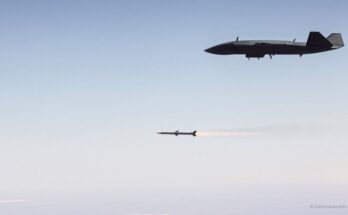The Indian Navy launched the fourth of its eventual six Scorpene submarines in its Project 75 effort on May 6. The launch marks an inflection point for a program that began in October 2005 when – after four years of negotiations – India inked a $3.5 billion contract with French shipbuilder DCNS (now Naval Group) for six diesel-electric attack submarines (SSKs) of the Scorpene design, plus technology transfer and localized production involving Mazagon Dock Ltd (MDL).
The fourth of the #IndianNavy’s stealth Scorpene class Submarines of Project 75 #Vela has been launched today at the Mazagon Dock Limited (MDL). Secretary @DefProdnIndia @drajaykumar_ias was the Chief Guest for the Launch ceremony. @Cmdmdl @SpokespersonMoD @DefenceMinIndia pic.twitter.com/aABxobCP2r
— SpokespersonNavy (@indiannavy) May 6, 2019
At the time of the contract signing, a tentative delivery schedule called for the first submarine to be delivered within five years.
However, by April 2010, the Indian government publicly admitted that the Project 75 program had been hit by massive slippages, which, in turn, would adversely impact the Navy’s underwater combat capabilities.
Like many of India’s large-scale defense projects, Project 75 fell victim to defense inflation stemming from cost growth in crucial parts. The byproduct of these rising costs became a delay in procurement of necessary components. Coupled with problems in absorbing the new technologies and augmenting industrial infrastructure at Mazagon Dock, the end result became delivery schedule slippage.
Due to these repeated delays, the delivery of the first submarine – INS Kalvari – slipped by almost five years, pushing its handover out to September 21, 2017. The sub was finally commissioned into Indian Navy service on December 14, 2017.
The delays with Project 75 exemplify the larger issues with India’s procurement approach and ambitious plans to modernize its armed forces in order to deter a potential collusive threat from neighboring rivals China and Pakistan. Goals such as broad artillery replacement for the Army and a revitalized and upgraded combat aircraft fleet for the Air Force remain ongoing decades after initiated, with new assets only added in spurts while aging, obsolete platforms continue in service.
In the Navy’s case, a long-standing 30-year diesel-electric submarine building plan approved by the Cabinet Committee on Security in 1999 called for the introduction of 12 new conventional submarines by 2012, followed by another 12 by 2030. However, that plan fell way off track, with just two new submarines – one of which is a nuclear-powered vessel, the SSBN Arihant – inducted through 2018.
With the Project 75 build finally gathering production momentum, however, a new class of submarines will soon be filling the Navy’s ranks. All six submarines are now either commencing sea trials or in advanced stages of manufacturing at MDL. The INS Vela was just launched; only the INS Vagir and INS Vagsheer remain to be launched, while the second and third submarines of the class, INS Khanderi and INS Karanj, are expected to be commissioned in June and December, respectively.
The @IndianNavy's 4th Scorpene-class submarine Vela launched at Mazagon Docks, Mumbai today. The second submarine, Khanderi, enters service shortly: https://t.co/hA20rLAHeZ pic.twitter.com/13whQiclet
— Livefist (@livefist) May 6, 2019
Completion of Project 75 will mark a key milestone for the Indian Navy, as its next major program, Project 75(I), was finally cleared by the country’s Defence Acquisition Council (DAC) in January.
This program – which calls for six diesel-electric attack submarines (SSKs) featuring air-independent propulsion and land-attack capability – falls under the Strategic Partnership (SP) category of the latest Defence Procurement Procedures.
Local media reports indicate that India’s Defence Ministry will initiate a global tender before the end of 2019 with the aim of selecting a foreign original equipment manufacturer (OEM) and shortlisting the necessary local manufacturer to tie up with the global bidders.
This matching of OEM and local industry partner is expected to take two to three years, after which the selected strategic partners will be expected to bid for the six-ship SSK tender. With downselection, then price negotiation and contract finalization, to follow, the lead-in submarine will not arrive for at least 10 years.
Thus, Project 75(I) constitutes yet another lengthened procurement timeline under the Modi government’s Make in India initiative. But at least the Indian Navy will have its six Scorpene-design submarines to operate until then as it confronts a growing Chinese submarine presence in the Indian Ocean Region.

Dan Darling is Forecast International’s director of military and defense markets. In this role, Dan oversees a team of analysts tasked with covering everything from budgeting to weapons systems to defense electronics and military aerospace. Additionally, for over 17 years Dan has, at various times, authored the International Military Markets reports for Europe, Eurasia, the Middle East and the Asia-Pacific region.
Dan's work has been cited in Defense News, Real Clear Defense, Asian Military Review, Al Jazeera, and Financial Express, among others, and he has also contributed commentary to The Diplomat, The National Interest and World Politics Review. He has been quoted in Arabian Business, the Financial Times, Flight International, The New York Times, Bloomberg and National Defense Magazine.
In addition, Dan has made guest appearances on the online radio show Midrats and on The Media Line, as well as The Red Line Podcast, plus media appearances on France 24 and World Is One News (WION).



